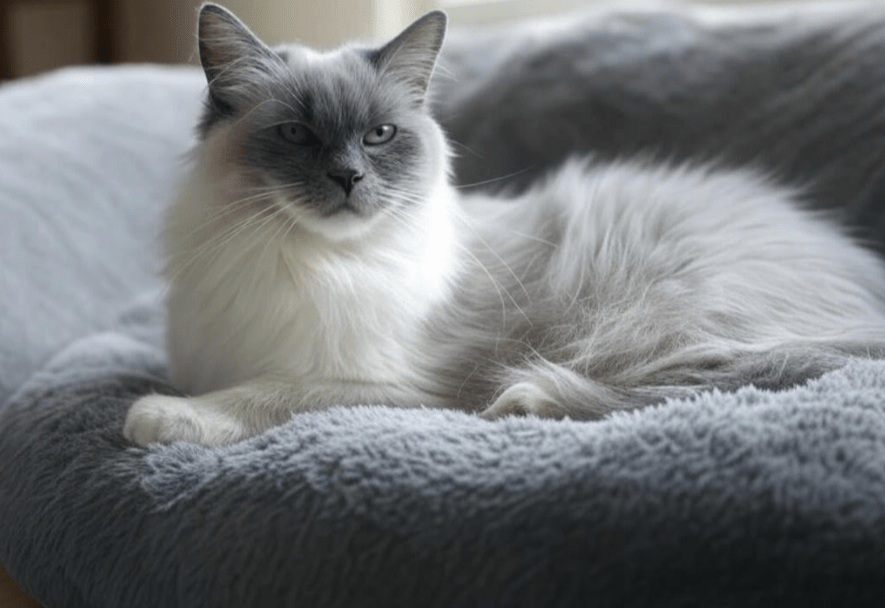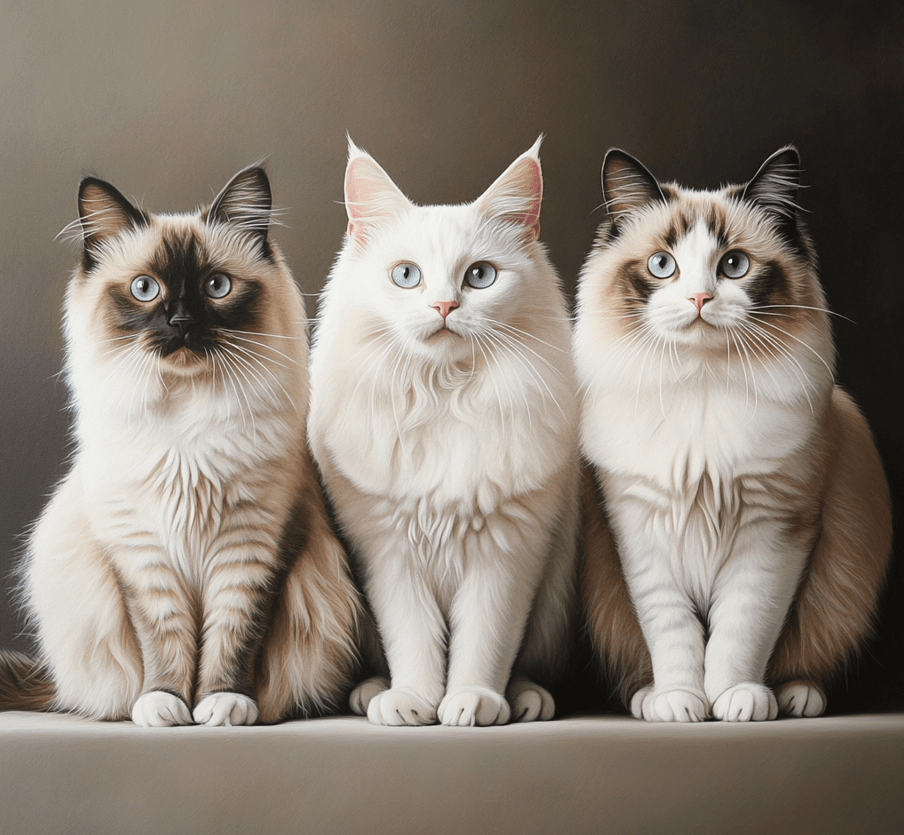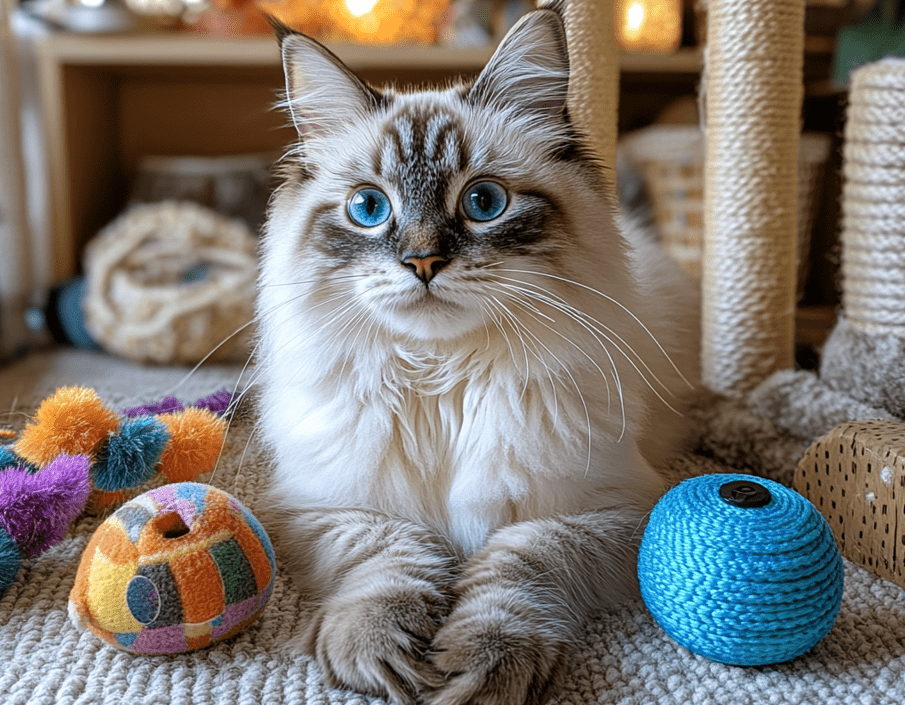
How to Keep Your Ragdoll Cat’s Coat Silky Without Daily Brushing
Ragdoll cats are beloved for their plush, semi-long coats that feel as luxurious as they look. The Ragdoll cat’s coat is a defining feature, with its soft, silky texture and vibrant colors that enhance their gentle, affectionate nature. However, maintaining that iconic coat doesn’t have to mean daily brushing or endless grooming sessions. In this comprehensive guide, we’ll explore how to keep your Ragdoll cat’s coat silky and healthy with minimal brushing, using smart grooming techniques, proper nutrition, and practical care tips. This article is designed to help Ragdoll owners maintain their cat’s stunning fur effortlessly.
Table of Contents
ToggleUnderstanding the Ragdoll Cat’s Coat
The Ragdoll cat’s coat is semi-long, dense, and plush, with a soft undercoat and longer guard hairs that give it a luxurious feel. Unlike some long-haired breeds, Ragdolls have minimal matting due to their coat’s unique texture, which lacks a thick undercoat in many cases. Their fur comes in a variety of patterns (colorpoint, mitted, bicolor) and colors (seal, blue, chocolate, lilac), all of which benefit from proper care to maintain their silky sheen.
Traits of a Healthy Ragdoll Coat
A well-maintained Ragdoll coat should exhibit:
Silky Texture: Smooth and soft to the touch, with no tangles or roughness.
Glossy Shine: A natural sheen that reflects light, enhancing color vibrancy.
No Mats: Free of knots or clumps, especially in high-friction areas like the belly or hindquarters.
Minimal Shedding: Light shedding, with no excessive loose fur.
Healthy Skin: Clear, flake-free skin with no redness or irritation.
Proper coat care not only keeps your Ragdoll looking beautiful but also supports their overall health and comfort.
Why Ragdoll Cat Coat Care Matters
A Ragdoll’s coat is a window into their well-being. Dull, matted, or greasy fur can indicate poor nutrition, stress, or underlying health issues. Regular coat maintenance without daily brushing offers several benefits:
- Prevents discomfort from mats or hairballs.
- Reduces shedding around your home.
- Enhances your Ragdoll’s confidence and relaxed demeanor.
- Strengthens your bond through gentle, stress-free grooming.
By focusing on efficient care strategies, you can keep your Ragdoll’s coat silky while saving time and avoiding over-grooming, which can stress these sensitive cats.
Efficient Ragdoll Cat Coat Care Strategies
To maintain your Ragdoll cat’s silky coat without daily brushing, focus on targeted grooming, nutrition, environmental care, and health monitoring. These strategies are designed for busy owners who want a low-maintenance routine.

1. Smart Grooming: Quality Over Quantity
While daily brushing isn’t necessary, periodic grooming is essential to prevent mats and distribute natural oils for a silky coat. The key is to use the right tools and techniques to maximize results with minimal effort.
Strategic Brushing
Brushing 2-3 times per week is sufficient for most Ragdolls, especially if you use efficient methods.
Tools:
Slicker Brush: Gently removes loose fur and prevents mats without pulling.
Wide-Tooth Comb: Ideal for detangling and checking for knots.
Grooming Glove: Perfect for Ragdolls who dislike brushes, as it mimics petting while removing hair.
Technique:
Brush in the direction of hair growth to avoid discomfort.
Focus on mat-prone areas: belly, armpits, hindquarters, and behind the ears.
Keep sessions short (5-10 minutes) to maintain your Ragdoll’s calm nature.
Timing: Brush during relaxed moments, like after a nap, to make it a positive experience.
Spot Detangling
Mats can form in high-friction areas, but daily brushing isn’t needed to prevent them. Instead, check for tangles weekly and address them promptly.
How to Detangle:
Use your fingers to gently separate small mats.
Apply a cat-safe detangling spray (e.g., TropiClean) to loosen stubborn knots.
Use a wide-tooth comb to work through the mat, starting at the tip and moving toward the skin.
Prevention:
Focus on mat-prone areas during brushing.
Keep your Ragdoll’s environment free of sticky substances (e.g., food or sap).
Bathing for Shine
Bathing isn’t a frequent necessity for Ragdolls, but an occasional bath can enhance coat silkiness and remove excess oils.

Frequency: Bathe every 2-3 months, or as needed (e.g., if your Ragdoll gets dirty).
Shampoo:
Choose a cat-specific, moisturizing shampoo with ingredients like oatmeal or aloe vera.
Avoid human shampoos, which can dry out the coat.
Steps:
1.Fill a sink with lukewarm water (avoid the face).
2.Gently wet the coat, apply shampoo, and lather.
3.Rinse thoroughly to prevent residue.
4.Towel dry or use a low-heat blow dryer if your Ragdoll tolerates it.
Parasite Checks
Fleas, ticks, or mites can damage your Ragdoll’s coat and cause irritation. Weekly checks prevent issues without daily grooming.
Signs to Watch:
Scratching or over-grooming.
Red, flaky skin.
Visible parasites or flea dirt (black specks).
Prevention:
Use vet-recommended flea preventatives monthly.
Comb through the coat with a fine-tooth comb to catch parasites early.
2. Nutrition: The Key to a Silky Coat
A balanced diet is critical for a Ragdoll cat’s coat health. Nutrient-rich food supports hair growth, skin hydration, and natural oil production, reducing the need for constant brushing.
Essential Nutrients for Coat Health
High-Quality Protein: Ragdolls need animal-based proteins (e.g., chicken, turkey, salmon) to strengthen hair follicles.
Omega-3 and Omega-6 Fatty Acids: Promote silkiness and reduce dryness. Found in fish oil and certain meats.
Biotin and Zinc: Support skin health and prevent flaking or dullness.
Vitamin E: Enhances coat shine and protects skin.
Hydration: Keeps skin supple, preventing brittle fur.
Best Foods for Ragdoll Coat Care
Wet Food: High in moisture and protein, wet food supports hydration and coat health. Brands like Royal Canin Ragdoll Formula or Wellness Core are excellent choices.
Raw Diets: Commercially prepared raw foods (e.g., Primal or Stella & Chewy’s) provide natural nutrients for a silky coat.
Dry Food: Use sparingly, opting for grain-free, high-protein options like Orijen or Acana to complement wet food.
Supplements:
Fish Oil: Adds omega-3s for shine (consult your vet for dosage).
Probiotics: Improve gut health, which supports skin and coat.
Tips:
Avoid foods with fillers (e.g., corn, wheat) or artificial additives, which can trigger allergies or dull fur.
Transition to new foods over 7-10 days to avoid digestive issues.
Provide fresh water in multiple bowls or a cat fountain, as Ragdolls prefer clean, accessible water.
Feeding Guidelines
Feed adult Ragdolls 2-3 meals daily, based on their weight (approximately 20-25 calories per pound).
Monitor portions to prevent obesity, which can lead to greasy or matted fur.
Consult a veterinarian for diet recommendations, especially for Ragdolls with sensitive skin.
3. Environmental Care: Supporting Coat Health
Your Ragdoll’s environment impacts their coat. Dry air, allergens, or stress can dull their fur, but simple adjustments reduce grooming needs.

Combating Dryness
Humidifiers: Indoor heating can dry out your Ragdoll’s coat. Use a humidifier to maintain 40-50% humidity.
Hydration Access: Place water bowls or a fountain in quiet areas to encourage drinking.
Minimizing Allergens
Clean Bedding: Wash your Ragdoll’s bedding weekly to remove dust and dander.
Dust Control: Vacuum regularly to reduce allergens like pollen or dust mites.
Safe Products: Use unscented, cat-safe cleaning supplies to avoid skin irritation.
Reducing Stress
Ragdolls are sensitive to stress, which can lead to over-grooming or dull fur. To keep them calm:
Provide enrichment like cat trees, toys, or window perches.
Stick to a consistent routine for feeding and play.
Offer a quiet retreat during disruptions (e.g., visitors or loud noises).
4. Health Monitoring: Preventing Coat Issues
Regular health checks catch issues that affect your Ragdoll’s coat, reducing the need for intensive grooming.
Common Coat-Related Issues
Allergies: Food or environmental allergies can cause itching or hair loss. Your vet may suggest a hypoallergenic diet.
Skin Infections: Bacterial or fungal infections lead to scaly or greasy fur. Early treatment is key.
Parasites: Fleas or mites damage the coat. Monthly preventatives are essential.
Obesity: Excess weight can cause greasy fur or matting. Maintain a healthy diet and exercise routine.
Veterinary Care Tips
Schedule annual vet visits, or biannual for senior Ragdolls (8+ years).
Report changes like dullness, thinning fur, or excessive grooming.
Keep vaccinations and parasite preventatives current.
Special Considerations for Ragdoll Cat Coat Care
Ragdolls have unique traits that influence their coat care needs. Tailor your approach for optimal results:
1. Seasonal Shedding
Ragdolls shed moderately, with slightly heavier shedding in spring and fall. Weekly brushing is usually enough, but increase to twice weekly during shedding seasons to manage loose fur.
2. Sensitive Skin
Some Ragdolls have sensitive skin, leading to flaking or irritation. Use hypoallergenic shampoos and soft grooming tools to minimize discomfort.
3. Age-Specific Needs
Kittens: Ragdoll kittens have softer coats that need gentle care to avoid stress.
Adults: Focus on maintaining silkiness and preventing mats.
Seniors: Older Ragdolls may have thinner fur. Support with nutrient-dense diets.
4. Indoor Lifestyle
Most Ragdolls are indoor cats, which protects their coat from dirt but increases exposure to dry air or allergens. Adjust their environment to compensate.
Common Mistakes to Avoid in Ragdoll Cat Coat Care
Over-Grooming: Excessive brushing can irritate your Ragdoll’s skin. Stick to 2-3 sessions weekly.
Using Harsh Products: Human shampoos or scented sprays can dry out the coat.
Ignoring Nutrition: Poor diet leads to dull, matted fur. Prioritize high-quality food.
Neglecting Mats: Small tangles can worsen quickly. Check weekly to catch them early.
Skipping Vet Visits: Coat changes often signal health issues. Address them promptly.
DIY Coat Care Solutions for Ragdolls
For hands-on owners, here are two cat-safe DIY recipes to enhance your Ragdoll’s coat without daily brushing:
1. Aloe Vera Coat Spray
Hydrates fur and reduces static.
Ingredients: 1 tbsp pure aloe vera gel, 1 cup distilled water.
Instructions:
1.Mix aloe vera and water in a spray bottle.
2.Lightly mist your Ragdoll’s coat before brushing.
3.Comb through to distribute and detangle.
2. Coconut Oil Skin Balm
Soothes dry skin (use sparingly).
Ingredients: 1 tsp organic coconut oil, melted.
Instructions:
1.Apply a small amount to dry skin patches.
2.Massage gently and wipe off excess.
3.Use weekly to hydrate.
Exercise and Play: Supporting Coat Health
Ragdolls are less active than some breeds, but gentle exercise improves circulation and reduces stress, both of which enhance coat health. Try:
1.Feather toys for light chasing.
2.Cat tunnels or low climbing structures.
3.Interactive puzzle feeders to engage their mind.
Aim for 15-20 minutes of play daily to keep your Ragdoll healthy and relaxed.
When to Seek Professional Help
If your Ragdoll’s coat shows persistent issues, consult a veterinarian or groomer. Warning signs include:
1.Mats that won’t loosen with gentle care.
2.Bald patches or thinning fur.
3.Excessive scratching or grooming.
4.Greasy, odorous, or flaky skin.
Professionals can diagnose issues like allergies or infections and recommend treatments, such as medicated shampoos or dietary changes.
Conclusion

Keeping your Ragdoll cat’s coat silky without daily brushing is entirely achievable with the right strategies. By combining targeted grooming, a nutrient-rich diet, a supportive environment, and regular health checks, you can maintain your Ragdoll’s plush, radiant fur with minimal effort. Avoid common mistakes like over-grooming or poor nutrition, and embrace your Ragdoll’s love for gentle interaction to make coat care a bonding experience.
With these expert tips, your Ragdoll will flaunt a silky, healthy coat that reflects their inner beauty and charm. Start applying these practices today, and enjoy a happy, well-groomed companion for years to come.
